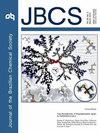Seasonal and Circadian Evaluation of the Pectis brevipedunculata Essential Oil and Its Acaricidal Activity against Rhipicephalus microplus (Acari: Ixodidae)
IF 1.3
4区 化学
Q3 CHEMISTRY, MULTIDISCIPLINARY
引用次数: 1
Abstract
Pectis brevipedunculata are native species and widely available in dry and semi-arid ecosystems showing high biotechnological potential. The objective of this study was to evaluate the circadian and seasonal chemical variation of the essential oil (EO) of P. brevipedunculata, as well as its acaricide effect on Rhipicephalus microplus larvae. Aerial parts were collected and submitted to the hydrodistillation process, and the chemical composition was determined by gas chromatography mass spectrometry (GC-MS). For the assays with R. microplus, the larval immersion test was performed. The main constituents were citral (75% of the EO), followed by α-pinene and limonene. In the seasonality analysis, the highest yields were in the months of April (2.08%) and August (2.05%), while in the study of circadian rhythm, the percentage was 2.0% at 6 p.m. in the rainy season, and 1.2%, dry season at 6 p.m. Concerning acaricidal activity (50% lethal concentration (LC50)), the April (1.17 mg mL-1), March (1.28 mg mL-1), June (1.37 mg mL-1), and October (1.27 mg mL-1) oils obtained were the most active and assays performed with circadian rhythm revealed in the rain season (April) at 6 p.m. and dry season (September) at 12 a.m. LC50 values of 1.75 and 1.75 mg mL-1, respectively. Additionally, this EO is selective to non-target organisms, i.e., ladybeetles and lacewing.短柄果胶精油对微小蜱螨(蜱螨目:伊蚊科)杀螨活性的季节和昼夜评价
短柄松果是一种本地物种,广泛存在于干旱和半干旱生态系统中,具有很高的生物技术潜力。本研究的目的是研究短柄藤精油(EO)的昼夜和季节化学变化,以及其对小尖鼻螨幼虫的杀螨作用。收集航空部件进行加氢蒸馏,采用气相色谱-质谱法(GC-MS)测定化学成分。采用幼虫浸渍法测定微氏夜蛾。其主要成分为柠檬醛(占总皂苷的75%),其次为α-蒎烯和柠檬烯。在季节性分析中,4月和8月的产量最高(2.08%),而在昼夜节律研究中,雨季下午6点的产量最高(2.0%),旱季下午6点的产量最高(1.2%)。在杀螨活性(50%致死浓度(LC50))方面,4月(1.17 mg mL-1)、3月(1.28 mg mL-1)、6月(1.37 mg mL-1)、10月(1.27 mg mL-1)的杀螨活性最高,并按昼夜节律测定,雨季(4月)下午6点,旱季(9月)凌晨12点。LC50值分别为1.75和1.75 mg mL-1。此外,这种EO对非目标生物(如瓢虫和草蛉)具有选择性。
本文章由计算机程序翻译,如有差异,请以英文原文为准。
求助全文
约1分钟内获得全文
求助全文
来源期刊
CiteScore
2.90
自引率
7.10%
发文量
99
审稿时长
3.4 months
期刊介绍:
The Journal of the Brazilian Chemical Society embraces all aspects of chemistry except education, philosophy and history of chemistry. It is a medium for reporting selected original and significant contributions to new chemical knowledge.

 求助内容:
求助内容: 应助结果提醒方式:
应助结果提醒方式:


